Abstract
In order to reveal the spinal reflexes involving the transmitter action of substance P (SP), the effects of capsaicin and an SP antagonist on the isolated spinal cord of the neonatal rat studied. When a single shock stimulus was given to a dorsal root (L3-L5) or a sciatic nerve, depolarizing responses of various time courses were recorded extracellularly from both ipsi- and contra-lateral ventral roots of the corresponding segments. The reflex response recorded from the contralateral ventral root consisted of fast and slow components, which will be referred to as contralateral fast and slow ventral root potentials (v.r.ps). The latter contralateral slow v.r.p. had a time-to-peak of 2-5 s and lasted 10-30 s. The threshold for the contralateral slow v.r.p. was about two times higher than that for the monosynaptic reflex, and it coincided with the threshold for activating the slow-conducting afferent fibres. The contralateral slow v.r.p. was abolished after the spinal cord was treated with capsaicin (1 microM for 30 min) in vitro. The contralateral slow v.r.p. was absent in the spinal cord derived from 4-day-old rats that had received capsaicin (50 mg kg-1, s.c.) on the 2nd day of life. The contralateral fast v.r.p. and other reflexes of fast time courses remained unaltered after treatment with capsaicin in vitro or in vivo. Administration of an SP antagonist, [D-Arg1, D-Pro2, D-Trp7,9 Leu11]-SP in concentrations of 5-16 microM depressed the contralateral slow v.r.p., but did not affect the monosynaptic reflex, the dorsal root potential and the contralateral fast v.r.p. [D-Arg1, D-Pro2, D-Trp7,9, Leu11]-SP (5 microM) markedly depressed the SP-induced depolarizing response recorded from the ventral root whereas the responses to noradrenaline, 5-hydroxytryptamine, neurotensin and thyrotrophin releasing hormone (TRH) were unaffected by the SP antagonist. The response of the ventral root to acetylcholine was slightly depressed by the antagonist. The SP antagonist at 5-10 microM did not exert any agonist action on the motoneurones. The present results in conjunction with those of previous studies support the hypothesis that SP released from certain primary afferent fibres acts as a neurotransmitter, producing in dorsal horn neurones slow excitatory postsynaptic potentials which lead to the generation of the contralateral slow v.r.p.
Full text
PDF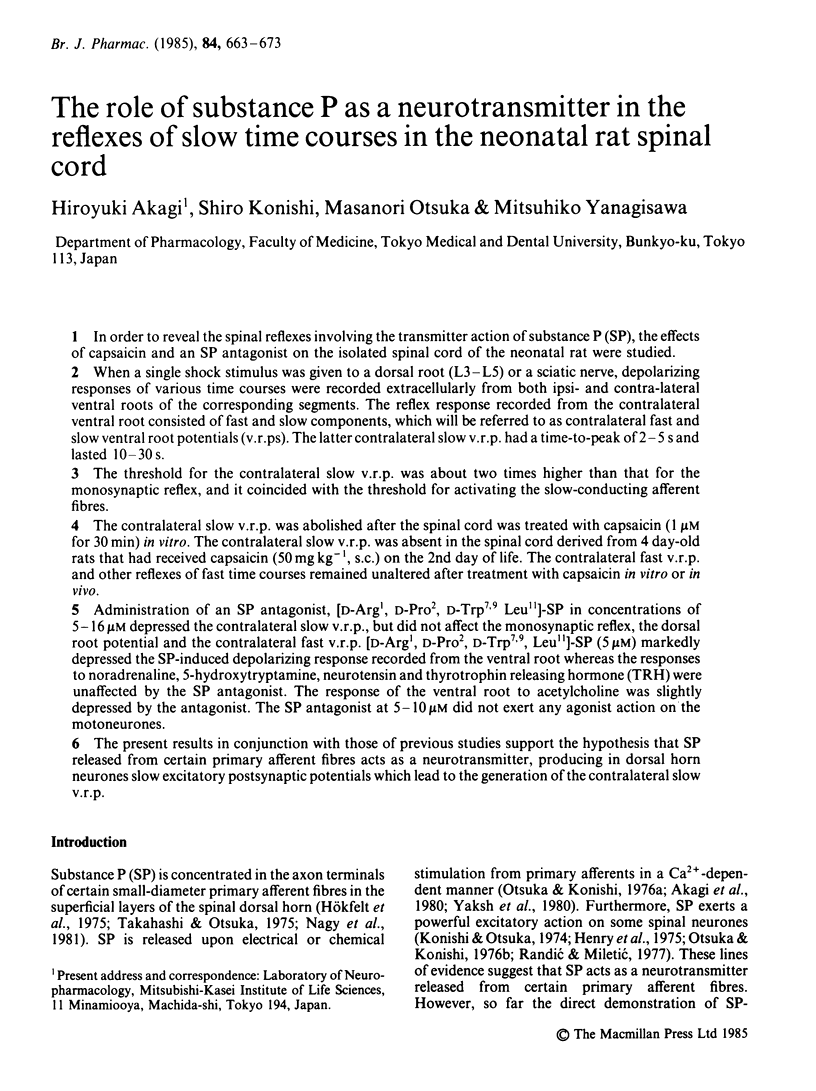
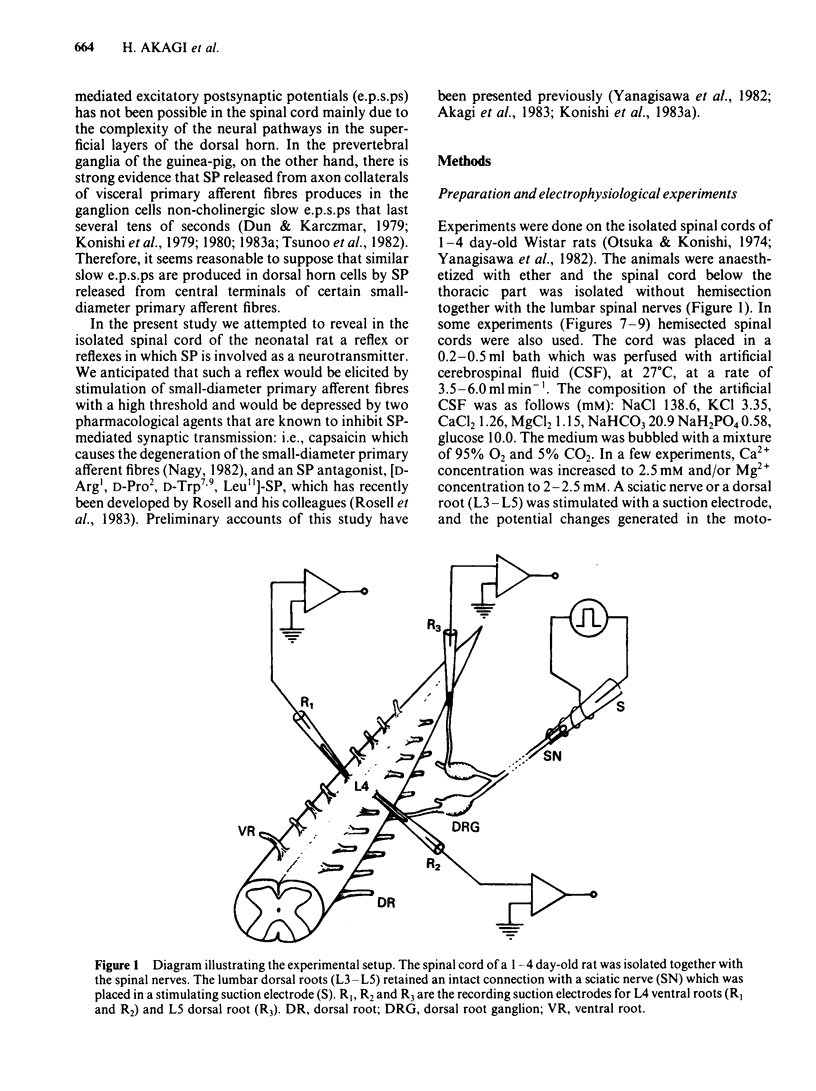
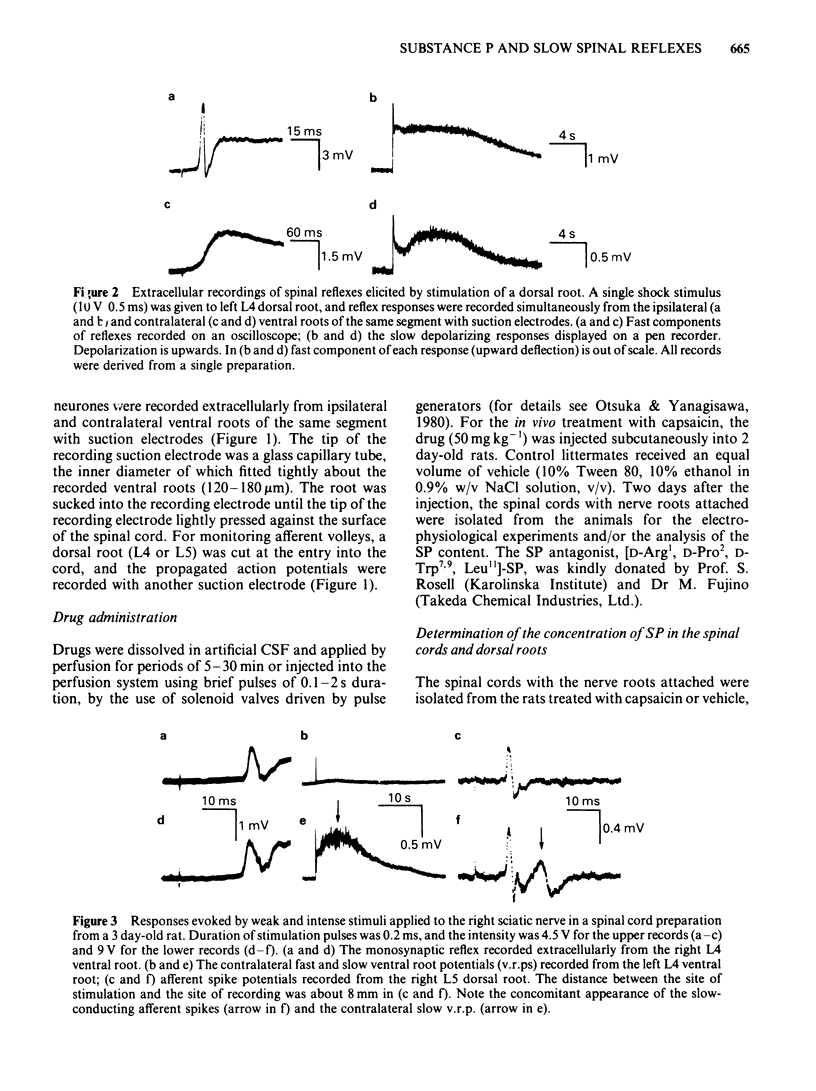
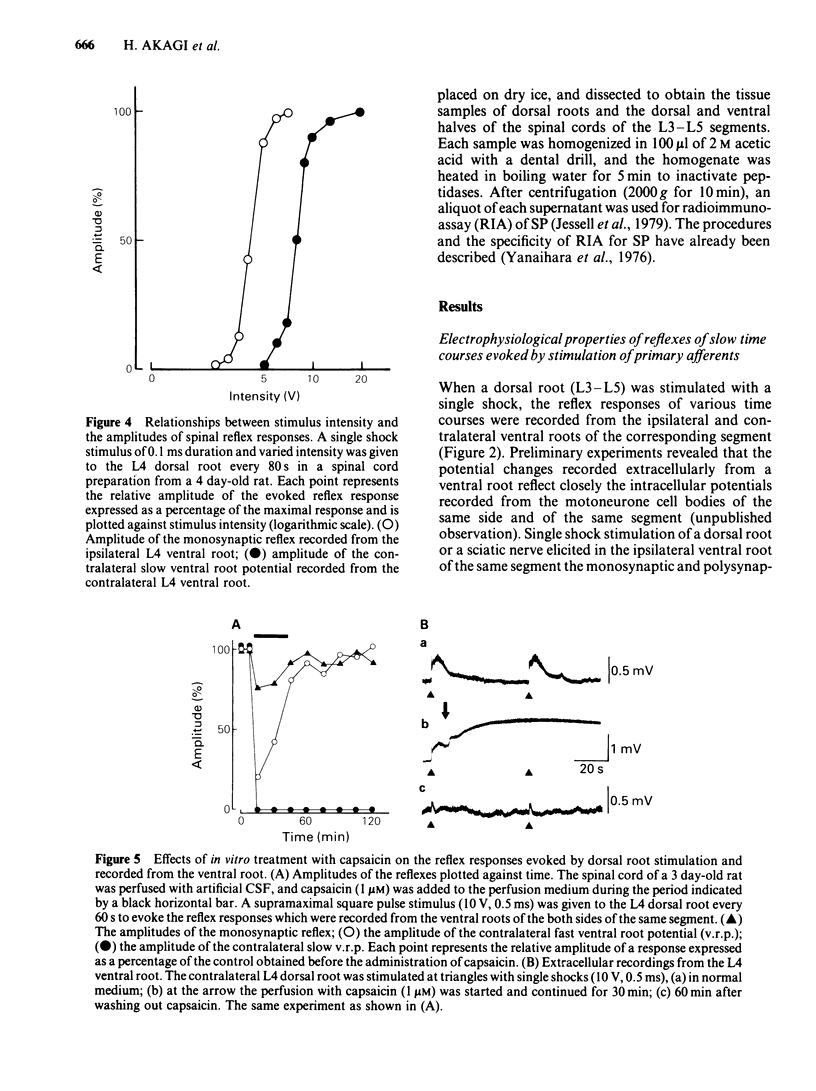
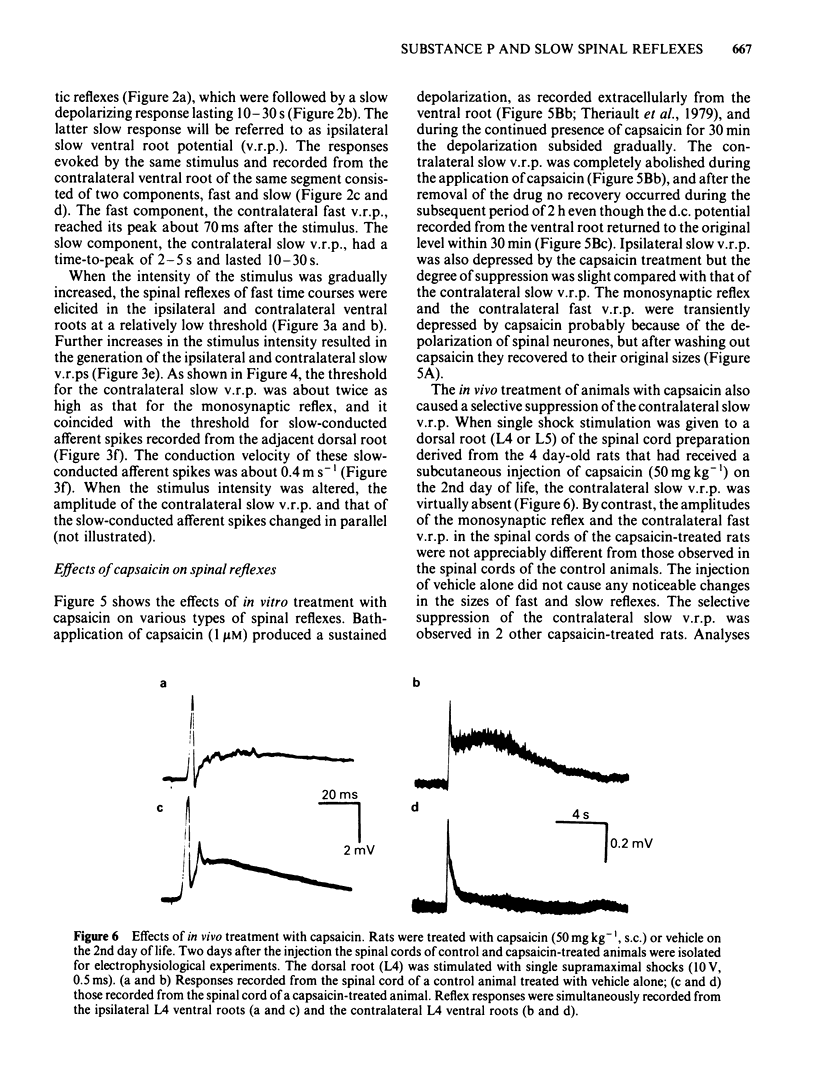
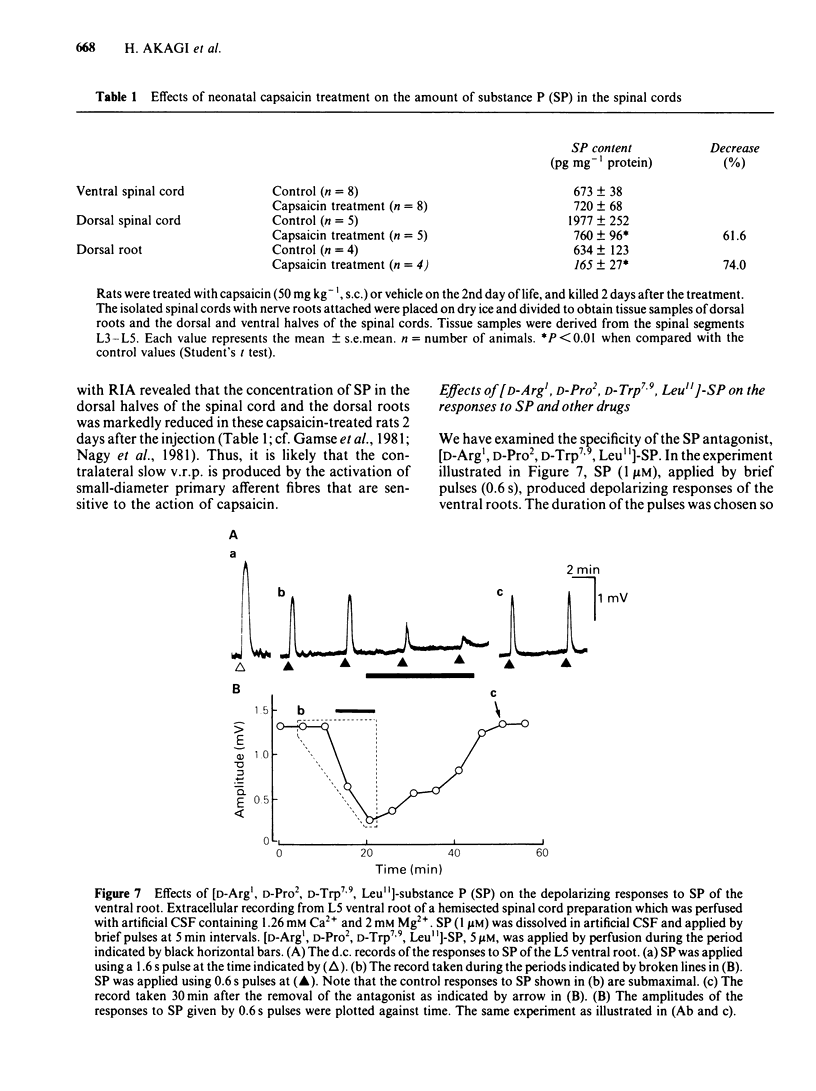
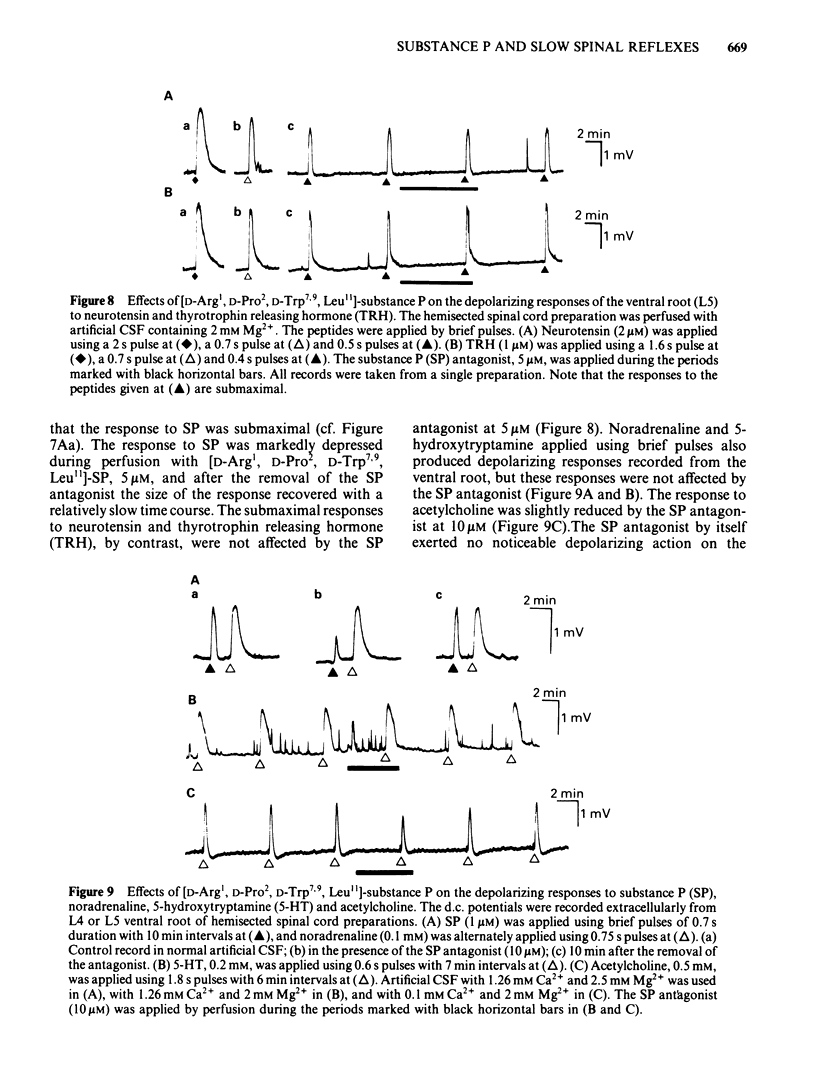
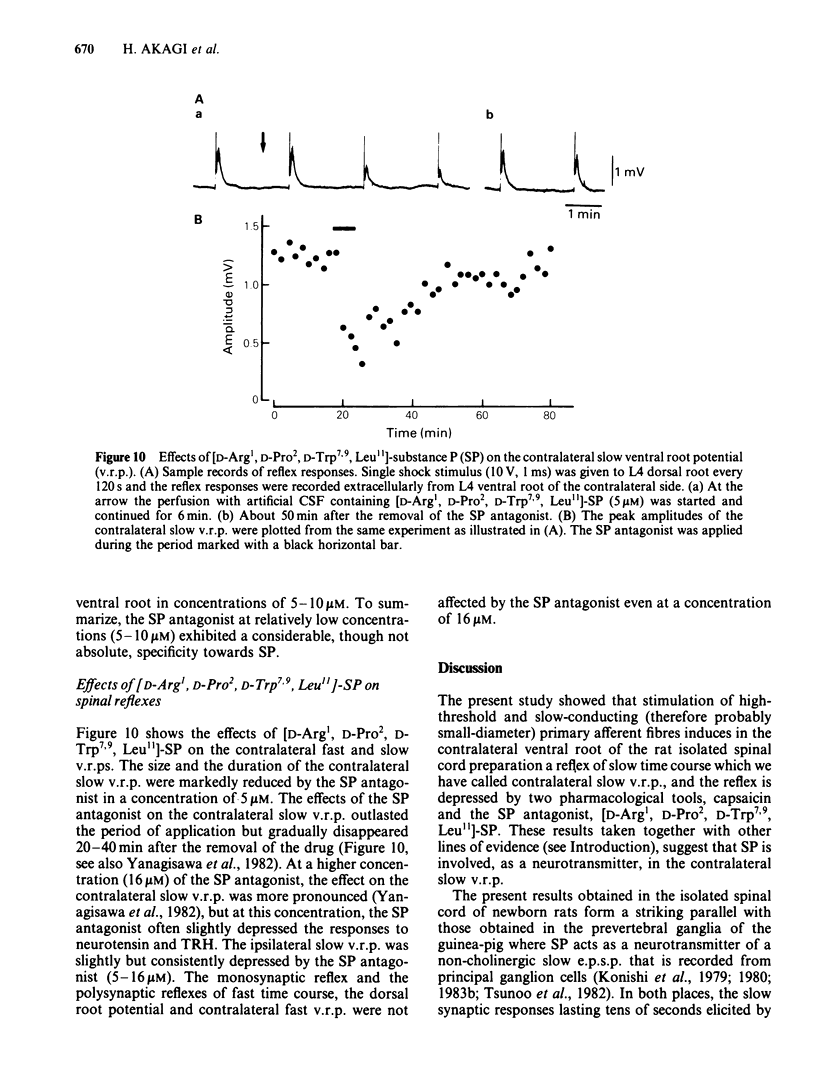
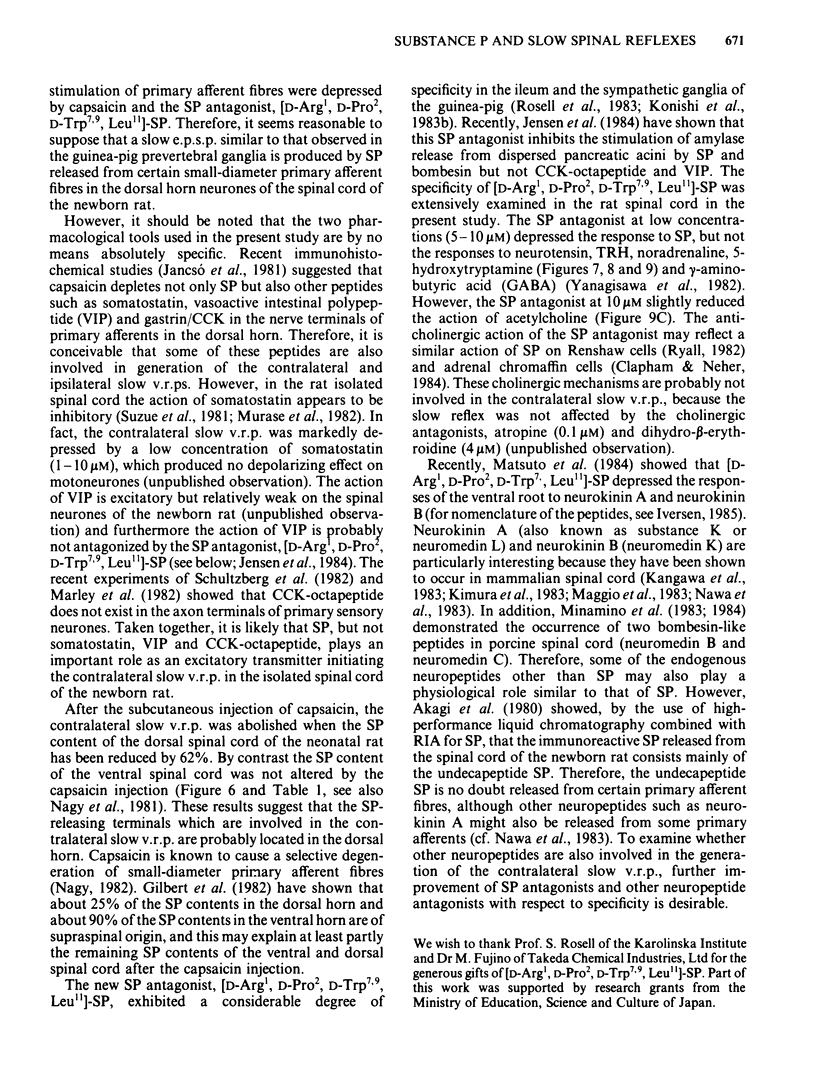
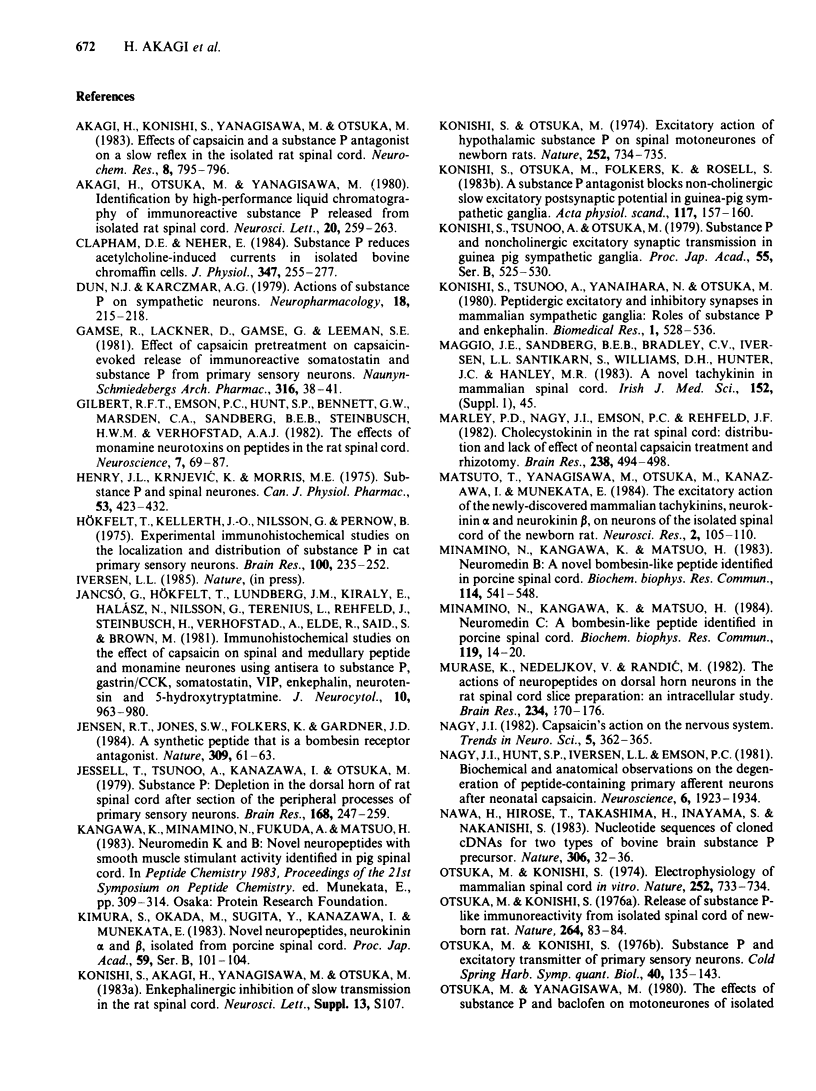
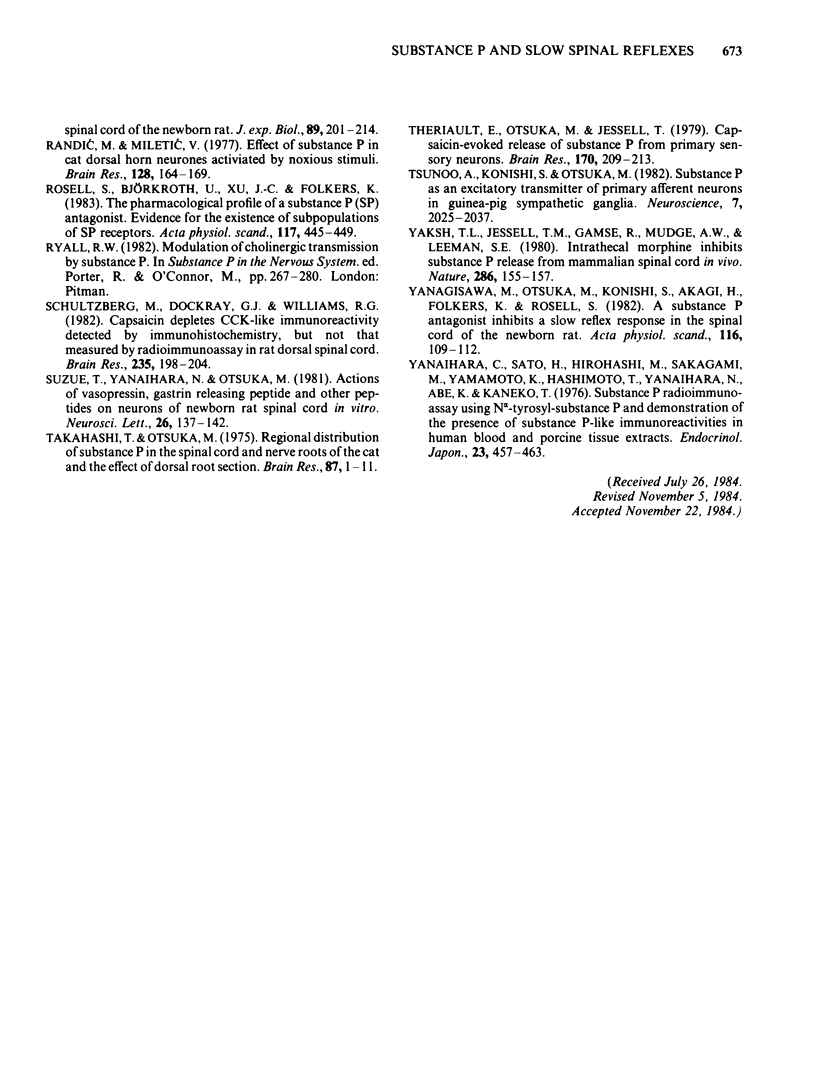
Selected References
These references are in PubMed. This may not be the complete list of references from this article.
- Akagi H., Otsuka M., Yanagisawa M. Identification by high-performance liquid chromatography of immunoreactive substance P released from isolated rat spinal cord. Neurosci Lett. 1980 Dec;20(3):259–263. doi: 10.1016/0304-3940(80)90157-3. [DOI] [PubMed] [Google Scholar]
- Clapham D. E., Neher E. Substance P reduces acetylcholine-induced currents in isolated bovine chromaffin cells. J Physiol. 1984 Feb;347:255–277. doi: 10.1113/jphysiol.1984.sp015065. [DOI] [PMC free article] [PubMed] [Google Scholar]
- Dun N. J., Karczmar A. G. Actions of substance P on sympathetic neurons. Neuropharmacology. 1979 Feb;18(2):215–218. doi: 10.1016/0028-3908(79)90064-9. [DOI] [PubMed] [Google Scholar]
- Gamse R., Lackner D., Gamse G., Leeman S. E. Effect of capsaicin pretreatment on capsaicin-evoked release of immunoreactive somatostatin and substance P from primary sensory neurons. Naunyn Schmiedebergs Arch Pharmacol. 1981 Feb;316(1):38–41. doi: 10.1007/BF00507224. [DOI] [PubMed] [Google Scholar]
- Gilbert R. F., Emson P. C., Hunt S. P., Bennett G. W., Marsden C. A., Sandberg B. E., Steinbusch H. W., Verhofstad A. A. The effects of monoamine neurotoxins on peptides in the rat spinal cord. Neuroscience. 1982 Jan;7(1):69–87. doi: 10.1016/0306-4522(82)90154-3. [DOI] [PubMed] [Google Scholar]
- Henry J. L., Krnjevíc K., Morris M. E. Substance P and spinal neurones. Can J Physiol Pharmacol. 1975 Jun;53(3):423–432. doi: 10.1139/y75-061. [DOI] [PubMed] [Google Scholar]
- Hökfelt T., Kellerth J. O., Nilsson G., Pernow B. Experimental immunohistochemical studies on the localization and distribution of substance P in cat primary sensory neurons. Brain Res. 1975 Dec 19;100(2):235–252. doi: 10.1016/0006-8993(75)90481-3. [DOI] [PubMed] [Google Scholar]
- Jancsó G., Hökfelt T., Lundberg J. M., Kiraly E., Halász N., Nilsson G., Terenius L., Rehfeld J., Steinbusch H., Verhofstad A. Immunohistochemical studies on the effect of capsaicin on spinal and medullary peptide and monoamine neurons using antisera to substance P, gastrin/CCK, somatostatin, VIP, enkephalin, neurotensin and 5-hydroxytryptamine. J Neurocytol. 1981 Dec;10(6):963–980. doi: 10.1007/BF01258524. [DOI] [PubMed] [Google Scholar]
- Jensen R. T., Jones S. W., Folkers K., Gardner J. D. A synthetic peptide that is a bombesin receptor antagonist. Nature. 1984 May 3;309(5963):61–63. doi: 10.1038/309061a0. [DOI] [PubMed] [Google Scholar]
- Jessell T., Tsunoo A., Kanazawa I., Otsuka M. Substance P: depletion in the dorsal horn of rat spinal cord after section of the peripheral processes of primary sensory neurons. Brain Res. 1979 May 25;168(2):247–259. doi: 10.1016/0006-8993(79)90167-7. [DOI] [PubMed] [Google Scholar]
- Konishi S., Otsuka M. Excitatory action of hypothalamic substance P on spinal motoneurones of newborn rats. Nature. 1974 Dec 20;252(5485):734–735. doi: 10.1038/252734a0. [DOI] [PubMed] [Google Scholar]
- Konishi S., Otsuka M., Folkers K., Rosell S. A substance P antagonist blocks non-cholinergic slow excitatory postsynaptic potential in guinea-pig sympathetic ganglia. Acta Physiol Scand. 1983 Jan;117(1):157–160. doi: 10.1111/j.1748-1716.1983.tb07192.x. [DOI] [PubMed] [Google Scholar]
- Marley P. D., Nagy J. I., Emson P. C., Rehfeld J. F. Cholecystokinin in the rat spinal cord: distribution and lack of effect of neonatal capsaicin treatment and rhizotomy. Brain Res. 1982 Apr 29;238(2):494–498. doi: 10.1016/0006-8993(82)90130-5. [DOI] [PubMed] [Google Scholar]
- Matsuto T., Yanagisawa M., Otsuka M., Kanazawa I., Munekata E. The excitatory action of the newly-discovered mammalian tachykinins, neurokinin alpha and neurokinin beta, on neurons of the isolated spinal cord of the newborn rat. Neurosci Res. 1984 Dec;2(1-2):105–110. doi: 10.1016/0168-0102(84)90008-7. [DOI] [PubMed] [Google Scholar]
- Minamino N., Kangawa K., Matsuo H. Neuromedin B: a novel bombesin-like peptide identified in porcine spinal cord. Biochem Biophys Res Commun. 1983 Jul 29;114(2):541–548. doi: 10.1016/0006-291x(83)90814-8. [DOI] [PubMed] [Google Scholar]
- Minamino N., Kangawa K., Matsuo H. Neuromedin C: a bombesin-like peptide identified in porcine spinal cord. Biochem Biophys Res Commun. 1984 Feb 29;119(1):14–20. doi: 10.1016/0006-291x(84)91611-5. [DOI] [PubMed] [Google Scholar]
- Murase K., Nedeljkov V., Randić M. The actions of neuropeptides on dorsal horn neurons in the rat spinal cord slice preparation: an intracellular study. Brain Res. 1982 Feb 18;234(1):170–176. doi: 10.1016/0006-8993(82)90483-8. [DOI] [PubMed] [Google Scholar]
- Nagy J. I., Hunt S. P., Iversen L. L., Emson P. C. Biochemical and anatomical observations on the degeneration of peptide-containing primary afferent neurons after neonatal capsaicin. Neuroscience. 1981;6(10):1923–1934. doi: 10.1016/0306-4522(81)90032-4. [DOI] [PubMed] [Google Scholar]
- Nawa H., Hirose T., Takashima H., Inayama S., Nakanishi S. Nucleotide sequences of cloned cDNAs for two types of bovine brain substance P precursor. Nature. 1983 Nov 3;306(5938):32–36. doi: 10.1038/306032a0. [DOI] [PubMed] [Google Scholar]
- Otsuka M., Konishi S. Electrophysiology of mammalian spinal cord in vitro. Nature. 1974 Dec 20;252(5485):733–734. doi: 10.1038/252733a0. [DOI] [PubMed] [Google Scholar]
- Otsuka M., Konishi S. Release of substance P-like immunoreactivity from isolated spinal cord of newborn rat. Nature. 1976 Nov 4;264(5581):83–84. doi: 10.1038/264083a0. [DOI] [PubMed] [Google Scholar]
- Otsuka M., Konishi S. Substance P and excitatory transmitter of primary sensory neurons. Cold Spring Harb Symp Quant Biol. 1976;40:135–143. doi: 10.1101/sqb.1976.040.01.015. [DOI] [PubMed] [Google Scholar]
- Otsuka M., Yanagisawa M. The effects of substance P and baclofen on motoneurones of isolated spinal cord of the newborn rat. J Exp Biol. 1980 Dec;89:201–214. doi: 10.1242/jeb.89.1.201. [DOI] [PubMed] [Google Scholar]
- Randić M., Miletić V. Effect of substance P in cat dorsal horn neurones activated by noxious stimuli. Brain Res. 1977 Jun 3;128(1):164–169. doi: 10.1016/0006-8993(77)90245-1. [DOI] [PubMed] [Google Scholar]
- Rosell S., Björkroth U., Xu J. C., Folkers K. The pharmacological profile of a substance P (SP) antagonist. Evidence for the existence of subpopulations of SP receptors. Acta Physiol Scand. 1983 Mar;117(3):445–449. doi: 10.1111/j.1748-1716.1983.tb00019.x. [DOI] [PubMed] [Google Scholar]
- Schultzberg M., Dockray G. J., Williams R. G. Capsaicin depletes CCK-like immunoreactivity detected by immunohistochemistry, but not that measured by radioimmunoassay in rat dorsal spinal cord. Brain Res. 1982 Mar 4;235(1):198–204. doi: 10.1016/0006-8993(82)90213-x. [DOI] [PubMed] [Google Scholar]
- Suzue T., Yanaihara N., Otsuka M. Actions of vasopressin, gastrin releasing peptide and other peptides on neurons on newborn rat spinal cord in vitro. Neurosci Lett. 1981 Oct 23;26(2):137–142. doi: 10.1016/0304-3940(81)90339-6. [DOI] [PubMed] [Google Scholar]
- Takahashi T., Otsuka M. Regional distribution of substance P in the spinal cord and nerve roots of the cat and the effect of dorsal root section. Brain Res. 1975 Apr 4;87(1):1–11. doi: 10.1016/0006-8993(75)90774-x. [DOI] [PubMed] [Google Scholar]
- Theriault E., Otsuka M., Jessell T. Capsaicin-evoked release of substance P from primary sensory neurons. Brain Res. 1979 Jul 6;170(1):209–213. doi: 10.1016/0006-8993(79)90957-0. [DOI] [PubMed] [Google Scholar]
- Tsunoo A., Konishi S., Otsuka M. Substance P as an excitatory transmitter of primary afferent neurons in guinea-pig sympathetic ganglia. Neuroscience. 1982;7(9):2025–2037. doi: 10.1016/0306-4522(82)90117-8. [DOI] [PubMed] [Google Scholar]
- Yaksh T. L., Jessell T. M., Gamse R., Mudge A. W., Leeman S. E. Intrathecal morphine inhibits substance P release from mammalian spinal cord in vivo. Nature. 1980 Jul 10;286(5769):155–157. doi: 10.1038/286155a0. [DOI] [PubMed] [Google Scholar]
- Yanagisawa M., Otsuka M., Konishi S., Akagi H., Folkers K., Rosell S. A substance P antagonist inhibits a slow reflex response in the spinal cord of the newborn rat. Acta Physiol Scand. 1982 Sep;116(1):109–112. doi: 10.1111/j.1748-1716.1982.tb10608.x. [DOI] [PubMed] [Google Scholar]
- Yanaihara C., Sato H., Hirohashi M., Sakagami M., Yamamoto K. Substance P radioimmunoassay using Nalpha-tyrosyl-substance P and demonstration of the presence of substance P-like immunoreactivities in human blood and porcine tissue extracts. Endocrinol Jpn. 1976 Dec;23(6):457–463. doi: 10.1507/endocrj1954.23.457. [DOI] [PubMed] [Google Scholar]


